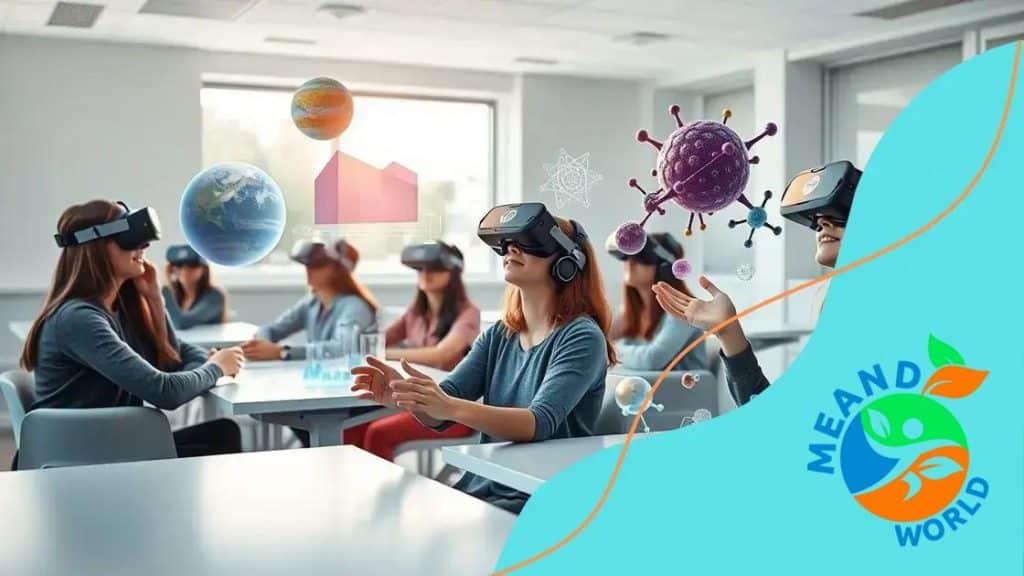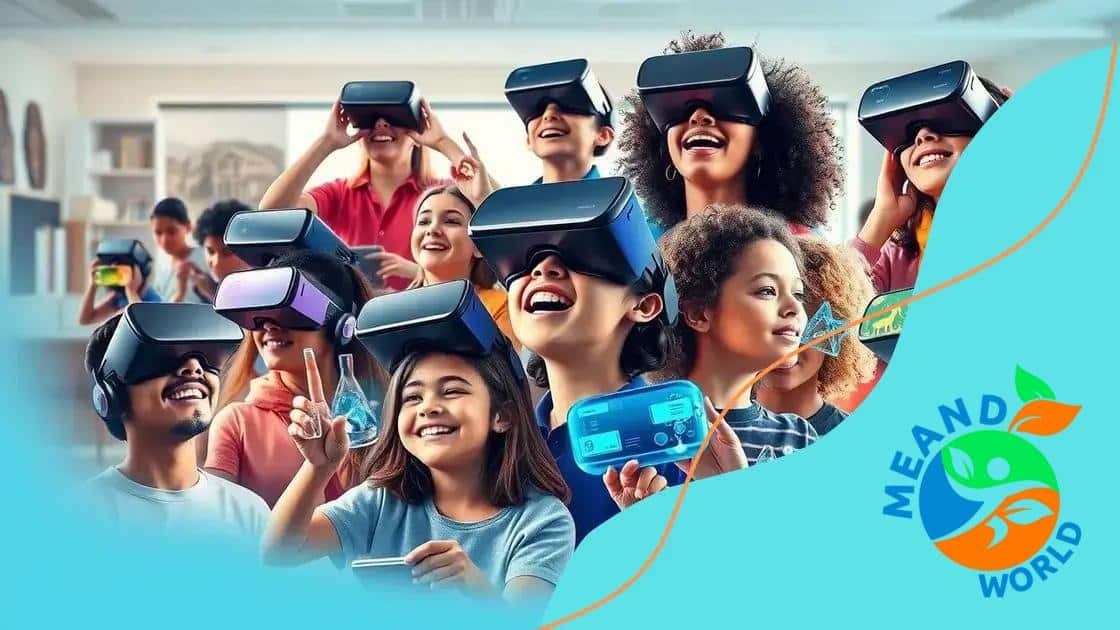Advancements in virtual and augmented reality in teaching

Anúncios
Advancements in virtual and augmented reality in teaching enhance student engagement and learning by providing immersive experiences, personalized learning environments, and opportunities for global collaboration.
Advancements in virtual and augmented reality in teaching are transforming the educational landscape, creating dynamic and interactive experiences for students. Have you ever imagined learning in a 3D environment, exploring historical sites or scientific phenomena? Let’s dive into how these technologies are reshaping the way we teach and learn.
Anúncios
Understanding virtual reality and augmented reality
Understanding virtual reality and augmented reality is crucial in today’s tech-driven world. These technologies offer students opportunities like never before. Imagine learning about ancient civilizations while walking through a digital recreation of their cities!
Anúncios
What is Virtual Reality?
Virtual reality (VR) immerses users in a fully digital environment. In this space, everything feels real. You can explore, interact, and engage with the surroundings as if you were actually there.
What is Augmented Reality?
On the other hand, augmented reality (AR) adds digital elements to the real world. This means you can see virtual objects overlaid on your view of the real world. For instance, with AR, students can look at a physical globe and see information about countries pop up on their screens.
Key Differences
- VR creates an entirely new environment.
- AR enhances the real world with digital content.
- VR typically requires a headset, while AR can be viewed on a smartphone.
- VR is often used for fully immersive experiences, while AR is perfect for interactive learning tools.
Both VR and AR are transforming education. They make complex concepts easier to understand. Imagine studying biology and being able to see the inner workings of a cell in three dimensions. This type of interactive engagement can make learning more effective and enjoyable.
Educators are embracing these advancements as they look for new ways to connect with students. With VR, students can participate in virtual field trips, exploring distant locations without leaving the classroom. AR technology allows them to visualize complicated processes in real-time.
The potential for enhancing student engagement is immense as these technologies continue to evolve. As teachers integrate VR and AR into their lessons, we can expect a more interactive and engaging learning experience for students.
Benefits of immersive technologies in education
Immersive technologies like virtual reality (VR) and augmented reality (AR) provide significant benefits in education. These tools enhance learning experiences, making lessons more engaging and effective.
Enhanced Engagement
Students are often more engaged when learning with immersive technologies. Instead of reading from textbooks, they can participate in interactive lessons. For example, using VR, students can enter a virtual ancient city, witnessing history firsthand.
Improved Retention
When students interact with learning materials in a practical way, they tend to remember information better. The combination of visual and tactile experiences helps solidify knowledge. Instead of traditional memorization, students recall what they have seen and done.
Personalized Learning Experiences
Immersive technologies allow for tailored learning approaches. Each student learns at their own pace, which can lead to improved outcomes. Teachers can track progress and adapt lessons accordingly, ensuring that every student understands the material.
- Interactive Simulations: This enables students to practice skills in a safe environment.
- Collaboration Opportunities: Students can work together in virtual spaces, enhancing teamwork.
- Access to Diverse Content: Learners can explore global cultures and scientific principles through immersive experiences.
Another major benefit is accessibility. Students with varying learning abilities can benefit from these technologies, breaking down barriers to education. Visual learners thrive in VR, while AR can assist auditory and kinesthetic learners.
As education continues to evolve, incorporating immersive technologies is becoming essential. Schools and educators are recognizing the potential to enhance both teaching and learning. By investing in these tools, they are preparing students for the future, equipping them with skills needed in a tech-driven world.
Case studies of VR and AR in classrooms

Case studies of VR and AR in classrooms showcase how these technologies are already making a difference in education. Schools are increasingly adopting immersive technologies to enhance learning. These real-world examples illustrate the benefits and effectiveness of such tools.
Example 1: Virtual Reality in History Lessons
In a high school located in California, teachers used VR to bring historical events to life. Students took virtual tours of ancient Rome, walking through the Colosseum and exploring historic landmarks. This method transformed a typical history class into an engaging experience. Students reported feeling more connected to the material as they visually experienced the past.
Example 2: Augmented Reality in Science Education
A middle school in New York implemented AR tools for science lessons. Students used tablets to view dynamic 3D models of the human body. Through AR, they learned about anatomy by interacting with these models. The hands-on approach helped students grasp complex concepts. Feedback indicated that students were more likely to ask questions and engage in discussions.
Example 3: VR for Language Learning
Another success story comes from a language immersion program in Texas. Students practiced conversational skills in VR environments that simulated real-life situations. This practice not only improved language proficiency but also built confidence. As students navigated virtual marketplaces and cafes, they used the target language in practical contexts.
- Enhanced Engagement: These case studies show a marked increase in student participation.
- Deeper Understanding: Immersive experiences foster greater comprehension.
- Real-World Applications: Students see how their studies align with actual experiences.
These real-life examples underline the potential of VR and AR in classrooms. They highlight how immersive technologies can create engaging learning environments that better prepare students for the future.
Challenges in implementing VR and AR in teaching
Implementing VR and AR in teaching brings several challenges that educators must navigate. These technologies can transform education, but obstacles must be overcome to achieve their full potential.
Cost of Technology
The most significant challenge is often the cost. Purchasing VR headsets and AR tools can be expensive. Many schools have tight budgets, making it difficult to invest in these innovative technologies. Additionally, maintaining and upgrading equipment can add ongoing expenses that schools may struggle to afford.
Training for Educators
Another challenge involves training educators. Not all teachers are familiar with these technologies. Successful implementation requires professional development programs to equip them with the necessary skills. Teachers need to feel comfortable using these tools to integrate them effectively into their lessons.
Access and Equity
Access to technology can also vary significantly among students. Some students may not have access to VR or AR experiences at home. This disparity can create an uneven learning environment. Schools must address these gaps to ensure that all students benefit equally from immersive technologies.
- Technical Difficulties: Frequent software updates and hardware malfunctions can disrupt lessons.
- Curriculum Integration: Finding ways to incorporate VR and AR into existing curricula can be challenging.
- Time Constraints: Teachers often feel pressured to cover specific materials before standardized testing, leaving little time for new technologies.
Despite these challenges, many educators see the value in VR and AR. They aim to create engaging learning environments that can capture students’ interest. By overcoming these barriers, schools can enhance education and prepare students for a technology-rich future.
The future of education with VR and AR technologies
The future of education with VR and AR technologies looks promising. As these tools continue to evolve, they have the potential to revolutionize how students learn and interact with content.
Personalized Learning Environments
In the future, classrooms may blend physical and virtual elements. Students could tailor their learning experiences using immersive technologies. For instance, a student struggling with a particular subject could access customized content in VR, making learning more relevant and engaging.
Global Collaboration
VR and AR technologies can also foster global connections among students. Imagine classrooms around the world working together on projects in virtual environments. Students could collaborate on scientific experiments or artistic endeavors without the limitations of geography.
Data-Driven Insights
As immersive technology becomes more integrated, it can provide valuable data about student engagement and learning outcomes. Teachers will receive insights into which methods are most effective. This data can drive curriculum enhancements and funding decisions.
- Increased Accessibility: Students with disabilities could benefit from tailored VR experiences that cater specifically to their needs.
- Enhanced Technical Skills: Familiarity with VR and AR technologies prepares students for modern workplaces.
- Content Creation Opportunities: Students could create their own AR experiences, fostering creativity and problem-solving skills.
The integration of VR and AR in education is paving the way for an innovative learning landscape. By overcoming current challenges, educators can leverage these technologies to enrich learning, foster collaboration, and prepare students for the future.
In conclusion, the integration of VR and AR technologies in education has the potential to create engaging, personalized learning experiences. While there are challenges to overcome, such as costs and training, the benefits are noteworthy. By adopting these technologies, educators can enhance student engagement, foster global collaboration, and prepare students for a future where technology plays a vital role. With the ongoing evolution of these tools, the classroom of tomorrow will be one where learning knows no bounds.
\n
\n
FAQ – Frequently Asked Questions about VR and AR in Education
How can VR and AR enhance student learning?
VR and AR create immersive experiences that engage students, making complex subjects easier to understand.
What challenges do schools face when implementing VR and AR?
Challenges include high costs, the need for teacher training, and ensuring equitable access for all students.
Can VR and AR improve collaboration among students?
Yes, these technologies enable global collaboration, allowing students to work together in virtual spaces, regardless of location.
What is the future of education with VR and AR?
The future includes personalized learning experiences and enhanced data insights, preparing students for technology-rich environments.





